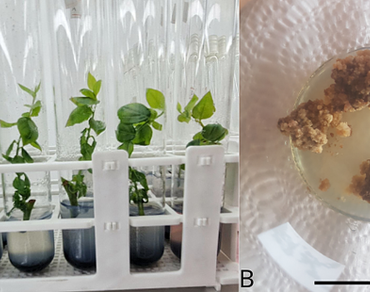Protoplast isolation systems in blueberry (Vaccinium corymbosum) and mortiño (Vaccinium floribundum): a novel and efficient approach
Cedeño Kathya Denissee Vargas, Sandoval Laura Elizabeth Vallejo, Dorca-Fornell Carmen, Gallegos Andrea Karolina Ortega, Guerrero Mónica Jadán
Short Communications | Published: 17 February, 2025
First Page: 1267
Last Page: 1273
Views: 1994
Keywords: Protoplasts isolation systems, Blueberry (Vaccinium corymbosum L), Mortiño (Vaccinium floribundum Kunth), n Ericales order
Abstract
The Ericales encompass a diverse group of plants, including commercially significant species such as persimmon, blueberries, kiwifruits, Brazil nuts, argan, and azalea. However, to date, no research has been conducted on the isolation of protoplasts in blueberry species such as Vaccinium corymbosum L. and Vaccinium floribundum Kunth (mortiño). The use of protoplasts for in vitro propagation has become a powerful tool to overcome sexual incompatibility barriers between plant species or genera and to transfer genes for resistance to diseases, pests, herbicides, and other stress factors, thereby enabling the production of a large number of high-quality hybrid plants. Consequently, the isolation of a substantial quantity of protoplasts and the establishment of an efficient regeneration protocols are essential prerequisites for the successful advancement of modern botany. Nonetheless, the establishment of efficient protoplast-based systems remain a challenge for numerous crop plants. The present work outlines the state-of-the-art of protoplast isolation systems within the Ericales order. Furthermore, we have successfully established the first and highly efficient system for the isolation of blueberry protoplasts from leaves employing an enzymatic solution comprising 1% cellulase, 1.5% macerozyme, and 0.3% pectinase at incubation for 28 h resulting in a yield of 5.95 × 104 protoplasts (FW). Additionally, callus induction was achieved in mortiño leaf explants by using semi-solid Woody Plant Medium supplemented with 2.5 mg/L of 2,4-Dichlorophenoxyacetic acid. Subsequently, we developed a highly efficient system for the isolation of mortiño protoplast, employing an enzymatic solution containing 2.5% cellulase, 3% macerozyme, and 0.3% pectinase atincubation for 5 hours resulting in a yield of 1.05 × 105 protoplasts (FW). Here, we have reported for the first time a highly efficient system for protoplast isolation in blueberries, making a significant milestone in the advancement of new plant breeding technologies for these species and other related crops.

References
Becerra C, Defilippi B, France A, González A, Hirzel J, Morales CG, Pedreros A, Riquelme J, Robledo P, Uribe H (2017) Manual de manejo agronómico del arándano. Boletín INIA, 98
Castro A (2016) Mejora de la propagación in vitro de Vaccinium corymbosum y evaluación de la actividad antioxidante en arándanos comerciales. Máster En Biología Molecular, Celular y Genética., 40
Castro Hinojosa CW (2017) Obtención de protoplastos del mesófilo de hojas de tomate (Solanumlycopersicum Mill.) mediante digestión enzimática.http://repositorio.espe.edu.ec/jspui/handle/21000/13773
Choury Z, Meschini R, Dell’Orso A, Fardusi MJ, Mugnozza GS, Kuzminsky E (2018) Optimized conditions for the isolation of mesophyll protoplasts along the growing season from Arbutus unedo and their use in single cell gel electrophoresis. Plant Cell Tissue Organ Cult (PCTOC) 132(3):535–543. https://doi.org/10.1007/s11240-017-1349-6
Chen K, Chen J, Pi X, Huang LJ, Li N (2023) Isolation, purification, and application of protoplasts and transient expression systems in plants. Int J Mol Sci 24(23):16892. https://doi.org/10.3390/ijms242316892PMID: 38069215; PMCID: PMC10706244
Cobo MM, Gutiérrez B, Torres AF, de Torres M L (2016) Preliminary analysis of the genetic diversity and population structure of mortiño (Vaccinium floribundumKunth). Biochem Syst Ecol 64:14–21. https://doi.org/10.1016/j.bse.2015.11.008
Debnath SC (2007) Propagation of Vaccinium in Vitro: a review. Int J Fruit Sci 6(2):47–71. https://doi.org/10.1300/J492v06n02_04
Georgieva M, Kondakova V (2021) In vitro propagation of Vaccinium corymbosum L. Bulg. J Agric Sci 27(2):323–327
Hasegawa S, Meguro A, Toyoda K, Nishimura T, Kunoh H (2005) Drought Tolerance of tissue-cultured seedlings of Mountain Laurel (Kalmia latifolia L.) Induced by an endophytic actinomycete II. Acceleration of Callose Accumulation and Lignification. Actinomycetologica 19(1):13–17. https://doi.org/10.3209/saj.19.13
Jadan M, Dorca-Fornell C (2019) Propagation methods in Babaco plants (Vasconcella x Helbornii). Trop Plant Res 6(1):37–45. https://doi.org/10.22271/tpr.2019.v6.i1.007
Jiang F, Zhu J, Liu H (2013) Protoplasts: a useful research system for plant cell biology, especially dedifferentiation. Protoplasma. https://doi.org/10.1007/s00709-013-0513-z
Llivisaca-Contreras SA, León-Tamariz F, Manzano-Santana P, Ruales J, Naranjo-Morán J, Serrano-Mena L, Chica-Martínez E, Cevallos-Cevallos JM (2022) Mortiño (Vaccinium floribundumKunth): an underutilized superplant from the Andes. Horticulturae 8(5):358. https://doi.org/10.3390/horticulturae8050358
McCown BH, Lloyd G (1981) Woody Plant Medium (WPM)—A Mineral nutrient formulation for microculture of Woody Plant species. HortScience 16:453–453
Meléndez M, Estefanía FR, Esther SP, Vásquez W, Racines-Oliva M (2021) Vaccinium spp.: Karyotypic and phylogenetic characteristics, nutritional composition, edaphoclimatic conditions, biotic factors and beneficial microorganisms in the rhizosphere. Scientia Agropecuaria 12:109–120. https://doi.org/10.17268/sci.agropecu.2021.013
Patel TK, Williamson JD (2016) Mannitol in plants, Fungi, and plant-fungal interactions. Trends Plant Sci 21(6):486–497. https://doi.org/10.1016/j.tplants.2016.01.006
RacheL, Pacheco J (2010) In vitro propagation of mature plants of Vaccinium meridionale (Ericaceae). Acta Bot Brasilica 24:1086–1095. https://doi.org/10.1590/S0102-33062010000400024
Reed KM, Bargmann BOR (2021) Protoplast Regeneration and Its Use in New Plant Breeding Technologies. Frontiers in Genome Editing, 3.https://www.frontiersin.org/article/https://doi.org/10.3389/fgeed.2021.734951
Roca W, Mroginski LA (1991) Cultivo de tejidos en la agricultura: Fundamentos y aplicaciones.https://cgspace.cgiar.org/handle/10568/53954
Rose JP, Kleist TJ, Löfstrand SD, Drew BT, SchönenbergerJ, Sytsma KJ (2018) Phylogeny, historical biogeography, and diversification of angiosperm order Ericales suggest ancient neotropical and east Asian connections. Mol Phylogenet Evol 122:59–79. https://doi.org/10.1016/j.ympev.2018.01.014
Suárez Padrón IE (2020) Cultivo de Tejidos Vegetales. Ed. Fondo Editorial Universidad de Córdoba.https://repositorio.unicordoba.edu.co/handle/ucordoba/2553
Tu Y, Xiong L, Leng B (2009) The Studies on Technique Conditions of Protoplast Isolation and Purification of Three Species of Rhododendron. Journal of Jiangxi Normal University (Natural Sciences Edition), 2
Veilleux RE, Compton ME, Saunders JA (2004) Use of protoplasts for plant improvement. In Plant Development and Biotechnology (pp. 213–224)
Xu X, Zhu H, Ren Y, Feng C, Ye Z, Cai H, Wan X, Peng C (2021) Efficient isolation and purification of tissue-specific protoplasts from tea plants (Camellia sinensis (L.) O. Kuntze). Plant Methods 17(1):84. https://doi.org/10.1186/s13007-021-00783-w
Author Information
Laboratorio de Cultivo de Tejidos Vegetales, Departamento de Ciencias de la Vida y la Agricultura, Universidad de las Fuerzas Armadas ESPE, Sangolquí, Ecuador